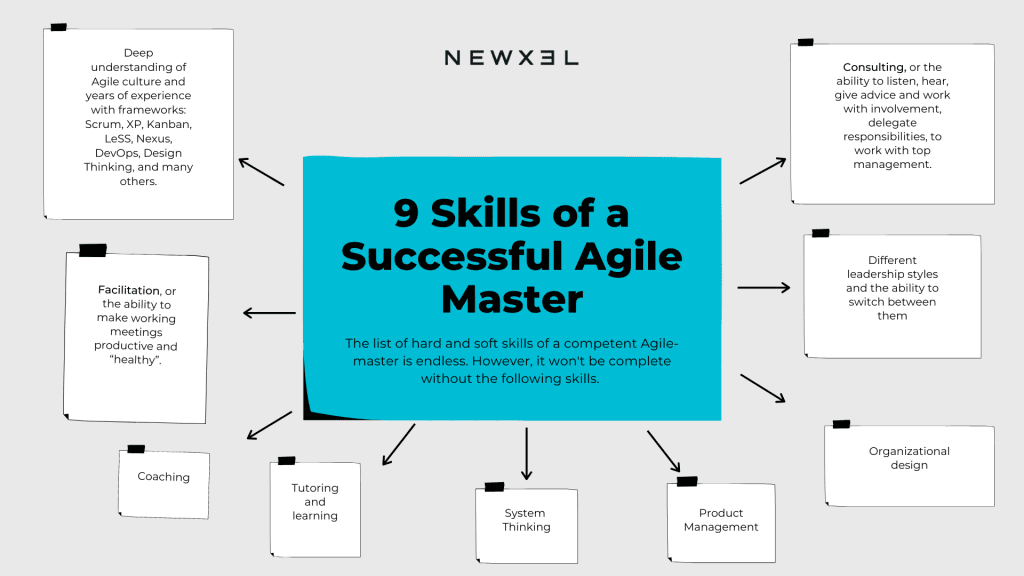Exciting Journey to Agile. Interview With Agile Coach Artem Bykovets
High demand for Agile specialists in 2021
Our convoluted and dynamically changing world and in the particular business environments are rapidly becoming even more and more complex. Needless to say that this process was only amplified by the Covid-19 pandemic which made a great point to any skeptics out there about the importance of agility and the willingness to change plans on the go.
From the very beginning of the pandemic, it became clear for the businesses that “Responding to change over following a plan“. Later on, during the lockdown, it became obvious that “Individuals and interactions over processes and tools” and “Customer collaboration over contract negotiation“. Those all are the values written in the Agile manifesto back in 2001.
Obviously, given the agile distributed teams challenges, the companies that quickly adapted to the new realities and showed agility in their business approach are the ones that preserved their revenues and in some cases even increased them. Therefore, the demand for Agile specialists has escalated even for those enterprises that previously denied the potential for such approaches to business management, not to mention the need for these professionals. However, those skeptics experienced that it is essential to adapt and transform quickly and with as minimum mistakes as possible, especially if most of the employees work from the remote or home office. And that is why the demand for experienced people, who can teach and adapt processes to Agile format, increased immensely!
How to assemble an Agile team? Create an engaging environment, hear your employees and build a great team?
Under these conditions when lots of companies headhunt for the Agile specialists, one might reasonably ask: How to build an Agile team and where should I start? Should we create an engaging environment, pulse check among the employees, or maybe create a new team? And how to ensure that during the transition into Agile implementation, the risks and disadvantages are eliminated?
We`ve asked this question to the Agile expert, Artem Bykovets, CEO / Organizational & Agile Coach at Simplesense. According to him, the attempt to implement Agile just as a target in itself can hinder your best intention to increase the firm`s agility. Perhaps you might have experienced such a situation before when installing some CRM or KPI in the firm but despite the efforts, your goal remained unattainable.
Artem Bykovets emphasizes that the agile transformation is about people and the right mindset. So before rolling out the Agile methods in your company, It’s important to understand that Agile is more about a philosophy, mindset, and culture rather than a set of practical procedural steps. More specifically, Agile is based on a set of 4 values and 12 principles. Given this, a company can’t simply impose this approach and implement it after a couple of training sessions or by hiring an Agile Manager. By doing this, a firm risks spending lots of costs, time, and effort on futile and ineffective things. Or in other words, to run into a fallacy of introducing healthy lifestyle days to all employees in the office without informing them why it is important and beneficial. Without sufficient information and a clear vision of the added value, personnel will seemingly adopt the behavior, but this will be only a superficial change that will not bring benefits in the long run.
To ensure effective and fluent implementation of the Agile approach, Artem Bykovets suggests starting from some brainstorming. First, the business should reflect on a couple of simple questions. They are:
- What do we need Agile for?
- What do we know about this philosophy and what tools are available to help me become more agile and flexible than we are now?
- What changes and investments are we willing to make and what under no circumstances?
- What is the principal problem we want to solve?
- Are the Agile methods the best instruments to solve it?
- And eventually, are we ready for this change as a business entity and community?
If the answers are well-thought and positive, the enterprise can move on to the next steps. It includes training of the personnel in the basics of what is “being Agile” and what are the approaches and tools to “doing Agile”. It is recommended that these pieces of training are provided for the majority of the staff from the top manager and to the front line developers. Of course, it is also advised to start involving managers, teams, team leaders, analysts, sellers, businesses as early as possible in the process, so that this transformation does not catch them off guard. Afterward, feedback from the employees can be collected and discussed together. This will help to map out the situation and see what of the acquired knowledge and tools the personnel is ready to take and apply immediately.
It is crucial to raise and formulate the answer to the question “What is this change for?“ For motivating the employees, the company should formulate its vision of why this change is needed. It won’t be an igniting story for employees if the company decides to implement Agile for the sake of implementing Agile. Just as the firm in general, each staff member would spend energy, time, effort to transform, so it is important to know what they would get in return and how they would benefit from the transition to make the process meaningful.
At the next stage, “new team agreements” are usually created. These are such informal rules of the game and serve as a kind of unwritten psychological and administrative contract. If there are some clear and well-communicated points, it would make it understandable and unambiguous for everyone in the company what are the goals the firm is trying to achieve? Who is responsible for what on the levels of a certain team, top management, Agile Coach, Product Manager, etc? What are the risks and potentially troubled areas and how will we address them? It is worth saying that quite often people are halted from the right actions and decisions, and sometimes just from the honest feedback by the fear of consequences and unwillingness to appear in a vulnerable position. That’s why it is of utmost importance to be transparent and communicate openly to the staff. Without transparency, one can probably succeed in building an Agile theater, rather than an Agile organization, because people would “play roles” and say the phrases that the managers and promoters of the transformation would expect to hear from them.
Hard and soft skills that an Agile-master should indispensably have
Don`t be surprised with the word “master” in this paragraph`s title. It’s there for a reason. In Scrum, one calls this role Scrum Master for it implies mastery. You probably don’t want to entrust your child (or yourself) to the Karate Master, who has no real experience but had a 2-day workshop with an experienced master. The same holds for your company, it deserves a competent coach or specialist to implement the Agile framework. Unfortunately, lots of enterprises hire inexperienced or unprofessional Agile / Scrum Masters and entrust the transformation in their often unconfident or poorly qualified hands. That’s why we selected the list of skills that a competent Agile-master needs.

The principal feature of the professional Agile-master is a deep understanding of Agile culture and many years of experience with different frameworks, such as Scrum, XP, Kanban, LeSS, Nexus, DevOps, Design Thinking, and many others. Experience of going through several transformations both internally and externally as a coach and organizational consultant / both successful and less successful, possibly even in different roles (for example, Developer, Scrum Master, Product) is an asset.
Among the critical skills areas the specialists’ highlight:
- Facilitation, or the ability to make working meetings productive and “healthy”. It includes also assisting people in finding consensus and agreement. Involving people in discussions and giving everyone a voice in a psychologically safe environment).
- Coaching, or the partnership with clients in a thought-provoking process that inspires them to maximize their personal and professional potential. Coaches respect clients as the experts in their life and work and believe that every client is creative, resourceful, and has the integrity to make decisions for themselves.
- Tutoring and learning consist of different coaching techniques from lectures/presentations to interactive group workshops where participants create their solutions and come to their conclusions. This is also an ability to explain complex things in simple language and illustrate them with live examples.
- Consulting, or the ability to listen, hear, give advice and work with involvement, delegate responsibilities, to work with top management.
- Different leadership styles and the ability to switch between them (from directive to facilitative, delegative, and so-called servant leadership). It has to do with the ability to work with different people and teams, creating and reconfiguring teams. This contains an understanding of “people & relationship management”.
- Organizational design, or understanding of differences and purposes of different principles of organizational structures and team building. An insightful Agile master will determine best whether it is worth employing a functional or cross-functional approach, permanent or customized for a certain project. This specialist will also figure out the best matching mode of time planning and project organization and choose from one backlog or source of tasks for a person or multiple PMs with their projects and priorities to divide people’s working time.
- Product Management, or command of techniques and tools of product development management, such as prioritization, task description, and decomposition, expectations and risk management, etc.
- System Thinking, or knowledge of the tools of systems thinking and the ability to work with the organization as an integral system. This is an extremely important skill, which minimizes the chances to slide into a hill of local optimizations and make a mess at the cross-team level.
The list of hard and soft skills of a competent Agile-master can go on forever. However, it won’t be complete without the next feature. The best practitioners of Agile methods, just like other high-skilled specialists, never stop learning! Probably this could be written down as a key Soft Skill before this voluminous account. It is the ability and willingness to constantly learn and change!
Steve Jobs said we didn’t hire talented people to tell them what to do. Which raises the question of how to make employees come up with ideas and solutions rather than problems?
Admittedly, this is an extremely broad question that probably deserves a separate article or maybe even a couple of them. There may be a million factors influencing personnel`s participation. They range from patterns of leadership in the organization, the level of compensation and professionalism, level of inner motivation, and a trivial question: “Why do I need it?” Sometimes companies just hire the wrong people and they “infect” the rest with indifference. Those mispicks can also be the wrong managers and they make people infantile by taking all the responsibility on themselves instead of delegating it to their subordinates at least partially.
Although there are lots of those factors impacting the proactiveness of the personnel, we adopt a constructive approach and will try to outline the main methods of stimulating the employees` initiatives and participation. We share the opinion of Steve Jobs who once said: We don’t hire talent to tell them what to do.
To boost participation within the company, it might be useful to apply a CX (Customer Experience) approach to employees (EX – Employee Experience) and develop the Employee Journey Mapping. Don’t get scared of this complicated name. Employee Journey Mapping includes carrying out a series of interviews with the personnel to get their answers and compare them to bypass the management or communication strategy. Based on those interviews, one can compare answers of those who bring up solutions and foster problems, those who used to offer solutions and stopped with it, of the newcomers and old-timers. This is a true source of many interesting things you might not even have imagined if the interviews are organized in a trustworthy tone. Because of this, it is essential to create an atmosphere of trust and safety so that the staff answers sincerely and tells the truth during these conversations. If the employees touch upon challenging and controversial topics, make sure they get needed support if any difficulties arise afterward. Needless to say that those interviews should not be turned into another satisfaction survey, after which at best it would not get worse.
It is important to reward desirable behaviors of the employees both financially and with verbal praise, promotion, giving them more power and autonomy in future projects. And as opposed to that, it is needed to correct undesirable behaviors and pass suitable corrective feedback or provide extra training.
Agile at work: the right conditions
You are probably curious when Agile works well and what are the right conditions for this so that you can optimize the company’s performance.
According to the Agile guru Artem Bykovets, the effects of Agile methods are the biggest when all participants of the process clearly understand why they need Agile, what it means and what are the rules of the game. It goes without saying that the sole understanding is not sufficient here. It is essential that all the parts follow the same rules without violating them and explaining the motivation for decisions made. It reminds a lot of the situation with the traffic rules. As long as everyone drives and parks by the same rules, the probability of an accident is very small. Being tuned to the same rules is much more important than certain practical issues like time difference between team members or the immediate reachability of the product-owner.
Against the background of COVID-19: how Agile helps companies in uncertain times
Agile and frameworks (for example Scrum and variations of its scaling to many teams) were designed and described as an alternative to traditional methods of development management. They came into being to create more adaptive processes according to the changing circumstances, requirements, and business environment. Besides, its focus is on the speed of delivery of the final result of decent quality (productivity), rather than the complete utilization of resources and staff time (efficiency). It is especially important in such “turbulent times” and when part of the team works out of the office. Agile approaches allow us to set up predictable cycles (sprints) in which we try to validate quickly the emerging hypotheses and release the incremental value proposition to the market, to quickly satisfy the needs of customers. And due to its adaptability, we can already introduce some small alterations after one sprint, based on the feedback and experience in the process of hypothesis validation. Because of this, the Agile approach is getting more and more popular not only in software development, but also in marketing, HR, and other spheres, where the level of uncertainty is growing, and long-term plans strongly to get out of the way.
Many customers that went through a big transformational journey a year or two before Covid note that they were very lucky to add agility right in time and dived into quarantine with minimal storm and loss of productivity.
The demand for Agile: a temporary trend or a long-term project approach
You might be perplexed with this heading which portrays Agile as a brand new topic. It might even bring about a misleading statement that like any hot new topic, Agile would not make it until the next season as everyone will forget about it and something new will come along.
However, to realize how mistaken this statement is, one should turn back to history. February 2021 marks 20 years (for some people in teams it would be less) since the Agile Manifesto was signed. Since then it has become more and more popular in different industries all over the world. Scrum is the most popular framework of the Agile family and celebrated its 25th anniversary in November 2020!
And yes, you`ve read it right, it’s a framework/tool, not a methodology. It has too little prescribed and a lot left to create within the context of the organization to be called a full-fledged methodology. The authors never set out to create a methodology because they believe that there are no universal methodologies in a complex environment and there are too many factors and dependencies unique to the context of each organization. And there was also XP (extreme development), which appeared in the mid-1980s. The roots and ideology of Agile grow from the Lean and many other works emerging in the process of management evolution. So it can be also said that Agile is another step of management evolution for organizations that create services and products in a complex world.
Books about project management and Agile methodologies
If you are novice Agile masters, product owners, and entrepreneurs and want to find out more about this topic, we have selected the recommended literature list:
- Henrik Kniberg Scrum and XP from the Trenches;
- Henrik Kniberg Kanban and Scrum: Making the Most of Both;
- Eric Ries The Lean Startup;
- Jeff Patton User Story Mapping: Discover the Whole Story, Build the Right Product;
- Luis Gonçalves and Ben Linders Getting Value out of Agile Retrospectives;
- Jeffrey Liker Dao Toyota;
- Jeff Sutherland Scrum: The Art of Doing Twice the Work in Half the Time;
- Lyssa Adkins Coaching Agile Teams;
- Craig Larman Scaling Agile/Lean Development;
- Jurgen Appelo Management 3.0.
If this list looks too short for you, check out the blog of the Organizational & Agile Coach Artem Bykovets.




